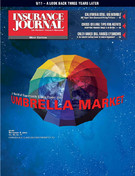The map shows a thin blue line skirting the edge of the Gulf and Atlantic coasts from Louisiana around Florida and all the way up to Maine to highlight the hurricane states. The blocks of red across the Western territories capture the earthquake states. Finally, the swath of green on the coast in Texas represents the doubly unfortunate—those communities considered both hurricane and earthquake states.
What most property insurance underwriters would see as a map of U.S. communities to avoid is dream territory for another insurer that sees gold in those territories.
International Catastrophe Insurance Managers, LLC (ICAT) in Boulder, Colo., specializes in one line and one line only: providing commercial insurance to businesses located in catastrophe-exposed regions of the U.S. ICAT now writes more than 60,000 buildings in 31 coastal states. Its $120 million in written premium ranks ICAT as one of the nation’s top 100 insurance brokerages.
The demand for its products is expected to grow as the country’s population continues to migrate to the Sunbelt and coasts and as small businesses come to appreciate the value of the coverage. According to government statistics, 40 percent of small businesses caught in a disaster never reopen.
ICAT utilizes catastrophe modeling software to forecast what damage might occur to properties in hurricane and earthquake prone areas.
Jack Graham, chairman and chief executive officer, got the idea for the underwriting manager he formed in 1998 while working as a reinsurance intermediary at E.W. Blanche Co. (now Benfield Blanche). Graham learned a lot about earthquake risks, as he headed E. W. Blanche Co.’s placement of the California Earthquake Authority’s $3.5 billion reinsurance program, the largest reinsurance placement in the history of the market. Graham also helped to found the Hawaii Hurricane Relief Fund.
After Hurricane Andrew, E.W. Blanche became one of the first companies to use computer tools for estimating damage from catastrophes. The methods were crude compared to the models of today but they boosted Graham’s faith in the value of objective analysis of risk.
“The fundamental theory behind ICAT is sound,” Graham stated.
The underwriting model ICAT developed factors in the proximity of the risk to seismic faults, the soil conditions at the location, construction materials and quality, the distance of the property to hurricane-exposed coastlines and other relevant underwriting characteristics.
Of course, ICAT would not be a true underwriter if it did not also know how to avoid risk. ICAT has developed proprietary tools to keep it from becoming too concentrated in the places and risks it does write.
“If you complement this kind of analysis of damageability with a good spread of risk, you have a pretty good blueprint,” Graham believes.
In terms of the types of properties that ICAT will write, they’re what Graham calls “generic Main Street” commercial properties such as apartments, condominiums, motels and offices.
ICAT inspects every building it insures to make sure it is what it is represented to be. ICAT also insists on 100 percent insurance to value. He said that he finds properties are on average under-insured by about 30 percent.
ICAT currently offers a Difference in Conditions (earthquake peril) Policy, a Named Peril (wind/hail only) Commercial Property Policy, and a Difference in Conditions (wind/hail perils) Policy.
Agents can access ICAT through a wholesaler or directly through the Internet for smaller accounts, those with up to $10 million of total insured value. For these, the average premium is under $4,000. About 65 percent of ICAT premiums and 95 percent of its policies are in this category of small business.
In addition to its high-level modeling technology, ICAT built its own Internet platform (www.icat.com) to automatically underwrite these smaller accounts.
ICAT works with wholesalers for most of its properties with more than $10 million in total insured value. The typical value ranges from $15 million to $25 million on these risks and the premiums average about $30,000.
“These are not automated underwriting. They are underwritten by human beings skilled in commercial property underwriting,” Graham added. “It’s critical to work with the wholesalers to put the puzzle together,” Graham stressed, explaining how ICAT’s single coverage must be integrated with other products.
ICAT is an underwriting manager for several member insurance companies of the XL Capital group, which has an “A+” rating from A.M. Best Company.
“We have built a better mousetrap,” Graham said.
It’s a mousetrap that is about to get bigger. Graham revealed that by late 2004 or early next year, ICAT will also begin offering products for homeowners in coastal areas.
Topics Catastrophe Underwriting Hurricane
Was this article valuable?
Here are more articles you may enjoy.


 10 Highest Class-Action Settlements in 2025 Eclipsed $70B Total: Duane Morris
10 Highest Class-Action Settlements in 2025 Eclipsed $70B Total: Duane Morris  Good Times for US P/C Insurers May Not Last; Auto Challenges Ahead
Good Times for US P/C Insurers May Not Last; Auto Challenges Ahead  Consumer Acceptance of Telematics Widens, Says Survey
Consumer Acceptance of Telematics Widens, Says Survey  Adjusters Launch ‘CarFax for Insurance Claims’ to Vet Carriers’ Damage Estimates
Adjusters Launch ‘CarFax for Insurance Claims’ to Vet Carriers’ Damage Estimates 


